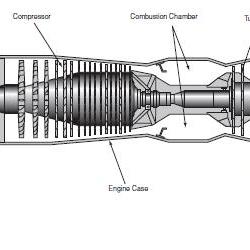Source Institutions
Source Institutions
Add to list Go to activity
Activity link broken? See if it's at the internet archive

In this two-part activity, learners work in pairs to examine the four basic stages of a turbine engine. During the first part of the lesson, learners visit three stations: Combustion, Compression, and Intake to discover what happens as different forces act on air. In the second part, learners build a model of a turbine engine. This activity emphasizes the scientific method including prediction, observation, data collection, and analysis. This lesson plan includes instructions on how to set up the stations, discussion questions, diagrams, black-line masters, and sample worksheets for learners.
- 10 to 30 minutes
- 45 to 60 minutes
- Over $20 per group of students
- Ages 11 - 14
- Activity, Experiment/Lab Activity, Lesson/Lesson Plan, Model
- English
Quick Guide
Materials List (per group of students)
- Intake Station (items per class)
- Small desk fan
- One sheet of paper
- Intake Station Directions (p8 of PDF)
- For Compression Station (items per class)
- Butcher paper
- Two desk fans that are the same size
- 20 6-inch lengths of string
- 20 5x7-inch index cards
- Tape
- Two markers
- Compression Station Directions (p9 of PDF)
- For Combustion Station (items per class)
- Flask, medium size
- Balloon
- Can of Sterno
- Matches or lighter
- Tongs
- Combustion Station Directions (p10 of PDF)
- For Part 2 (items per student)
- cardboard paper towel core
- flexible straw
- 12"x12" sheet of aluminum foil
- 4 paper circles 1-1/2" diameter
- small 1-inch paper clip
- 3-oz paper cup
- pair of scissors
- tape
- glue (not glue sticks)
- Copies of Student Work Sheet Part 2 (p13 of PDF)
Subjects
-
Earth and Space Science
-
Earth Structure
- Atmosphere
-
Earth Structure
-
Engineering and Technology
-
Engineering
- Aerospace Engineering
- Transportation Engineering
-
Technology
- Transportation
-
Engineering
-
Physical Sciences
-
Heat and Thermodynamics
- Heat and Temperature
-
Energy
- Energy and Power
- Work and Machines
-
Motion and Forces
- Machines
-
Heat and Thermodynamics
-
The Nature of Science
-
The Scientific Process
- Asking Questions
- Conducting Investigations
- Gathering Data
- Formulating Explanations
- Communicating Results
-
The Scientific Process
Audience
To use this activity, learners need to:
- see
- read
- be mobile
- touch
Learning styles supported:
- Involves teamwork and communication skills
- Involves hands-on or lab activities
Other
Includes alignment to state and/or national standards:
Includes assesments for student learning:
This resource is part of:
Access Rights:
- Free access
By:
- NASA
Rights:
- Public domain, ,
